
 |
Tea Clipper |
 |
| from TeaAntiques.com | ||
| Edition Eighty Four |
With my newsletter this month visiting Hôtel de Beaumont, a charming French home, I thought it appropriate to make my Featured Antique something from 18th Century France; a stunning Sèvres butter dish and cover.
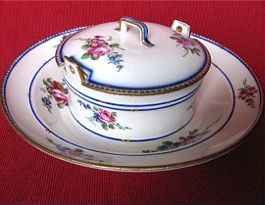
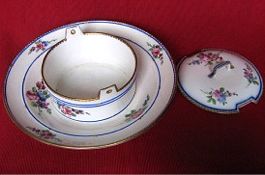
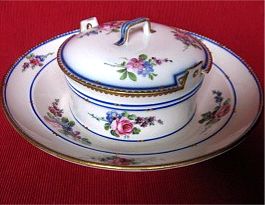
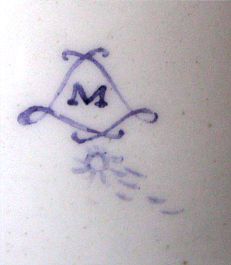 This
delightful butter dish is clearly marked on the underside of the base plate with
interlaced 'L' of the famous Sèvres factory. Inside of the interlaced 'L's is the
date letter 'M', equating to 1765.
This
delightful butter dish is clearly marked on the underside of the base plate with
interlaced 'L' of the famous Sèvres factory. Inside of the interlaced 'L's is the
date letter 'M', equating to 1765.
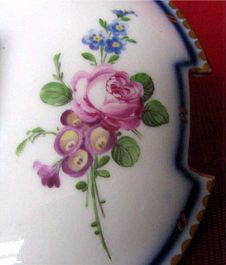 The
circular butter tub, which is in the form of a butter 'piggin' with two raised side
handles, is actually part of the base plate as one piece. Then there is a cover
to the butter tub which has two cut outs for it to fit between the two handles,
thus preventing it from slipping off.
The
circular butter tub, which is in the form of a butter 'piggin' with two raised side
handles, is actually part of the base plate as one piece. Then there is a cover
to the butter tub which has two cut outs for it to fit between the two handles,
thus preventing it from slipping off.
The base plate, which is in the shape of a quite deep dish, has the same form of decoration as on the tub, with magnificent colourful bouquets of flowers. There is also a raised blue and gilded line around the base plate and a further blue line at the rim, together with rich gilding. A truly magnificent butter dish for any house or Château.
More details of this item and other tea related antiques can be found by visiting my web site at www.TeaAntiques.com.
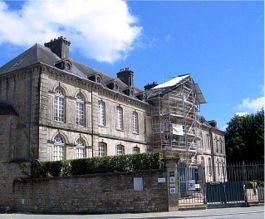 During
the summer months, I took a trip across the English Channel to Normandy, France.
The Normandy peninsula is a beautiful area, with some fine cliff and sand dune walks
to the West side, pretty market towns and rolling green and lush landscape. Many
of the houses in this part of France are constructed of locally honed Granite stone,
and as such often have thick walls. These houses do bear a resemblance to the houses
you find around the Cornwall, England, this because they share the same geographical
properties.
During
the summer months, I took a trip across the English Channel to Normandy, France.
The Normandy peninsula is a beautiful area, with some fine cliff and sand dune walks
to the West side, pretty market towns and rolling green and lush landscape. Many
of the houses in this part of France are constructed of locally honed Granite stone,
and as such often have thick walls. These houses do bear a resemblance to the houses
you find around the Cornwall, England, this because they share the same geographical
properties.
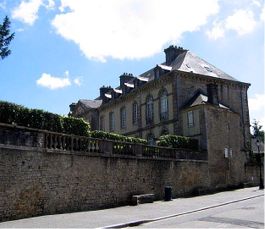 One
town in Normandy which in the 17th and 18th centuries was a very wealthy town was
Valognes, known as Le Petit Versailles Normandy. It is evident, despite 75%
of the town's building being bombed in the second World War, as it still boasts
some very fine buildings from this period. The Hôtel de Beaumont is indeed a very
fine example.
One
town in Normandy which in the 17th and 18th centuries was a very wealthy town was
Valognes, known as Le Petit Versailles Normandy. It is evident, despite 75%
of the town's building being bombed in the second World War, as it still boasts
some very fine buildings from this period. The Hôtel de Beaumont is indeed a very
fine example.
Hôtel de Beaumont is situated near to the centre of Valognes and is a large
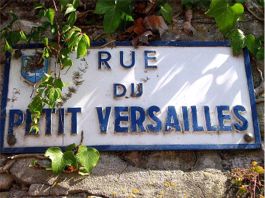 aristocrat's
town house. Built in the 17th century, it was later changed in the 18th century
to charming house that we see today. The house stands in an attractive walled garden
and from the road the front of the Hôtel has an elegant facade with a central curved
bay in which is the front door with demi-lune fan light above. The small
paned windows with frames in white add to the elegance of the building, especially
the arched windows within the bay. It was unfortunate that on my visit there was
restoration work being carried out on the central bay and so was shrouded in scaffolding.
This impressive bay has four Louis XV ionic pilasters on the ground floor supporting
a base and frieze for the second floor. Above this are Ionic pilasters to the roof
line above which it supports a triangular pediment in which is the coat of arms
of the Beaumont family.
aristocrat's
town house. Built in the 17th century, it was later changed in the 18th century
to charming house that we see today. The house stands in an attractive walled garden
and from the road the front of the Hôtel has an elegant facade with a central curved
bay in which is the front door with demi-lune fan light above. The small
paned windows with frames in white add to the elegance of the building, especially
the arched windows within the bay. It was unfortunate that on my visit there was
restoration work being carried out on the central bay and so was shrouded in scaffolding.
This impressive bay has four Louis XV ionic pilasters on the ground floor supporting
a base and frieze for the second floor. Above this are Ionic pilasters to the roof
line above which it supports a triangular pediment in which is the coat of arms
of the Beaumont family.
The entrance for visitors is through a small doorway in the wall of the rear garden and through a small visitor centre. There are very good and enthusiastic guided tours of the Hôtel, but they are understandably given in French.
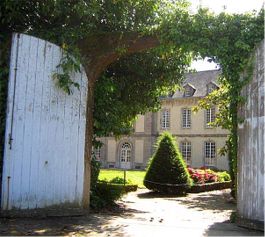
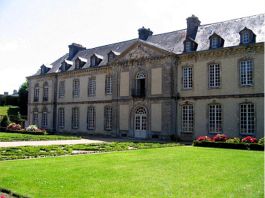
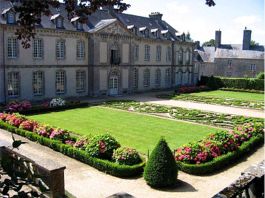
The views of the back of the Hôtel show a grand yet relatively simple facade. There is a central block with door and arched fan light on the ground floor and an arched window on the first floor. As with the front, there is a triangular pediment in which can be seen the Beaumont family coat of arms. Either side of the central block are two plain wings with a projecting end wing to each. A fine slate hipped roof with dormer windows completes this elevation.
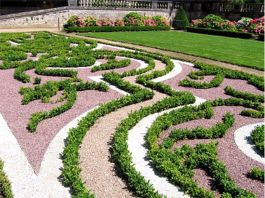 Approaching
the central door along a gravel path there are lawns on either side and a typical
French style knot garden, giving a well balanced and formal garden approach to the
Hôtel.
Approaching
the central door along a gravel path there are lawns on either side and a typical
French style knot garden, giving a well balanced and formal garden approach to the
Hôtel.
Entering the Hôtel you go straight into an unusual and elegant Stone Hall with an amazing flying staircase. There are two straight staircases in front of you, then at the landing level, they meet and then a single flight of stairs bridges its way directly above your head to the first floor. It is the staircase itself that is impressive as the rest of the Hall is a quite simple plain stone wall and floor construction. The stairs have a simple iron balustrade.
 The
family still live in the Hôtel in one wing, in the other wing are the rooms that
are open to the public, which have some fine period features and furniture. The
first room is the Dining Room or La Salle à Manger. This is a beautiful room
of Louis XVIII style and has a large dining table covered with a white damask table
cloth and laid up for the dessert course of a dinner.
The
family still live in the Hôtel in one wing, in the other wing are the rooms that
are open to the public, which have some fine period features and furniture. The
first room is the Dining Room or La Salle à Manger. This is a beautiful room
of Louis XVIII style and has a large dining table covered with a white damask table
cloth and laid up for the dessert course of a dinner.
 On
the table are some French green floral plates with silver cutlery of the period.
The table is elegantly furnished with decoration imitating white carved sugar with
a columned pagodas interlaced with flowers and foliage and dotted about with delicate
porcelain figurines. Fruits and sweetmeats also adorn the table. At the far end
of the room is a marble toped side table upon which is a selection of family silver.
This includes a fine hot water kettle.
On
the table are some French green floral plates with silver cutlery of the period.
The table is elegantly furnished with decoration imitating white carved sugar with
a columned pagodas interlaced with flowers and foliage and dotted about with delicate
porcelain figurines. Fruits and sweetmeats also adorn the table. At the far end
of the room is a marble toped side table upon which is a selection of family silver.
This includes a fine hot water kettle.
 Moving
on to the next room is Le Salon, or Drawing Room. This is a very attractive
and elegant room with wood panelled walls, painted in soft pastel tones and gilded
carvings. A handsome pink marble fireplace is to one end of the room, above which
a gilt framed mirror which reflects the light from the huge glass chandelier. In
the panelling above the mirror are two carved and gilded cherubs at play.
Moving
on to the next room is Le Salon, or Drawing Room. This is a very attractive
and elegant room with wood panelled walls, painted in soft pastel tones and gilded
carvings. A handsome pink marble fireplace is to one end of the room, above which
a gilt framed mirror which reflects the light from the huge glass chandelier. In
the panelling above the mirror are two carved and gilded cherubs at play.
 There
is a parquetry floor to this room with a large floral Aubouson rug in the centre
and is furnished with some delightful furniture. The room has a relaxed intimate
feel about it and is in the style of King Louis XVIII. On a marble topped side table
there is some French porcelain which includes a small globular teapot and some Paris
cups and saucer.
There
is a parquetry floor to this room with a large floral Aubouson rug in the centre
and is furnished with some delightful furniture. The room has a relaxed intimate
feel about it and is in the style of King Louis XVIII. On a marble topped side table
there is some French porcelain which includes a small globular teapot and some Paris
cups and saucer.



In the centre of the room is a table that is actually a games table, the top sliding to reveal the games stored within. Other elegant furniture in the room are Fauteuils (open armed chairs), Console tables, Ladies writing desk, etc.
 The
next room is the Music Room. In here is an attractive Piano Forte, reputed to be
only one of 32 of its kind. It was acquired in 1811 and is a very fine instrument.
The polished wooded case is embellished with bronze ornamentation, including coiled
serpents at either end of the keyboard. There is also a French table on which some
French tea wares and next to this table an elegant open armed chair with a ladies'
fan sat on it.
The
next room is the Music Room. In here is an attractive Piano Forte, reputed to be
only one of 32 of its kind. It was acquired in 1811 and is a very fine instrument.
The polished wooded case is embellished with bronze ornamentation, including coiled
serpents at either end of the keyboard. There is also a French table on which some
French tea wares and next to this table an elegant open armed chair with a ladies'
fan sat on it.




 Leaving
this room visitors are led up a small servant staircase to the first floor and shown
into the La Chambre des enfant, Nursery Bedroom. This is a fascinating museum
type collection of old toys, dolls and children's furniture and apparel. In a panelled
wall cupboard, which the young guide opened, there are shelves stacked with more
children's period toys and clothes. One of the best pieces in this room is a boat
shaped swinging Child's cot. At the front of the cot and at the top of the post
at the back which supports the drapes are carved and gilded swans heads.
Leaving
this room visitors are led up a small servant staircase to the first floor and shown
into the La Chambre des enfant, Nursery Bedroom. This is a fascinating museum
type collection of old toys, dolls and children's furniture and apparel. In a panelled
wall cupboard, which the young guide opened, there are shelves stacked with more
children's period toys and clothes. One of the best pieces in this room is a boat
shaped swinging Child's cot. At the front of the cot and at the top of the post
at the back which supports the drapes are carved and gilded swans heads.


 Next
to the Nursery Bedroom , is La Chambre de la Comtesse de Flourine, the Countess's
Bedroom. This feminine room is decorated with bold floral wallpaper. On the fireplace
stands a charming French Boulle clock, above which a portrait of an aristocratic
lady. The Comtesse de Flourine died in this room in 1904 at the age of 52. The room
contains a beautiful harp, finely carved and painted. A dressing table has a gilt
framed dressing mirror and some of the Comtesse's clothes are displayed, including
shoes and on a French Fauteuil, a mask ready as if to attend a masked ball.
Next
to the Nursery Bedroom , is La Chambre de la Comtesse de Flourine, the Countess's
Bedroom. This feminine room is decorated with bold floral wallpaper. On the fireplace
stands a charming French Boulle clock, above which a portrait of an aristocratic
lady. The Comtesse de Flourine died in this room in 1904 at the age of 52. The room
contains a beautiful harp, finely carved and painted. A dressing table has a gilt
framed dressing mirror and some of the Comtesse's clothes are displayed, including
shoes and on a French Fauteuil, a mask ready as if to attend a masked ball.



Leading on from this Bedroom is the Cabinet de Toillette, bathroom for the Comtesse. This contains many accoutrements of the period when the Comtesse lived here.



 Making
your way down the servant stairs to basement level you are shown the room where
servants would carry out such duties as ironing. There is a plate rack on the wall
containing blue and white plates and curiously on the table, an English Minton porcelain
tureen. Next to this room is a servants' type Hall where they would eat. This room
concludes the tour of the house. The guide then leads you out to the front of the
house and talks about the history of it before leaving the visitors to enjoy the
gardens at will.
Making
your way down the servant stairs to basement level you are shown the room where
servants would carry out such duties as ironing. There is a plate rack on the wall
containing blue and white plates and curiously on the table, an English Minton porcelain
tureen. Next to this room is a servants' type Hall where they would eat. This room
concludes the tour of the house. The guide then leads you out to the front of the
house and talks about the history of it before leaving the visitors to enjoy the
gardens at will.


The gardens at the back of the Hôtel de Beaumont are set out in a romantic style with some formal compartments, including a rose garden with formal shaped hedges and at its centre a metal pergola. from the terraces of the garden you get view of the town and its fine church in the centre of the town.
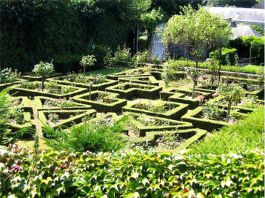
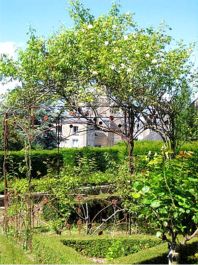
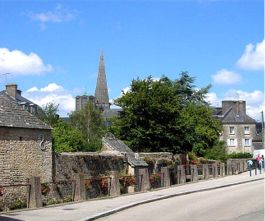
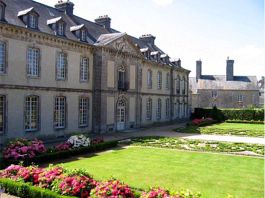 Hôtel
de Beaumont in my opinion is well worth a visit. Not a huge grand house or Chateau,
it is an elegant aristocrat's town house with a lot of style, distinction and interest.
The guides are informative and friendly too. Sadly there is no tea room at this
property, but it is but a few minutes walk into the town centre where there are
typical French Cafés to be found and enjoyed.
Hôtel
de Beaumont in my opinion is well worth a visit. Not a huge grand house or Chateau,
it is an elegant aristocrat's town house with a lot of style, distinction and interest.
The guides are informative and friendly too. Sadly there is no tea room at this
property, but it is but a few minutes walk into the town centre where there are
typical French Cafés to be found and enjoyed.
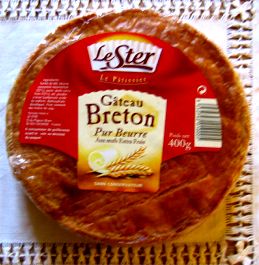
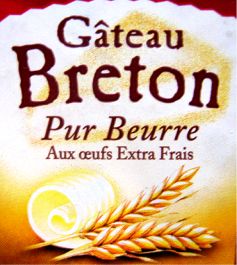
When in France, it is a good time to sample some of their delicious cakes for afternoon tea. There are regional cakes to sample, one such cake being Gâteau Breton, a very rich butter cake, rather like English shortbread. Some of these have a filling in the middle of a conserve, such as a strawberry or raspberry conserve or even a dried prune layer. It is a fine cake to enjoy with tea, even better served with the very thick Normandy cream which can be bought loose at the town markets.
To review past newsletters, just follow this link:
Past newsletters.
To subscribe to this free newsletter -
Click here